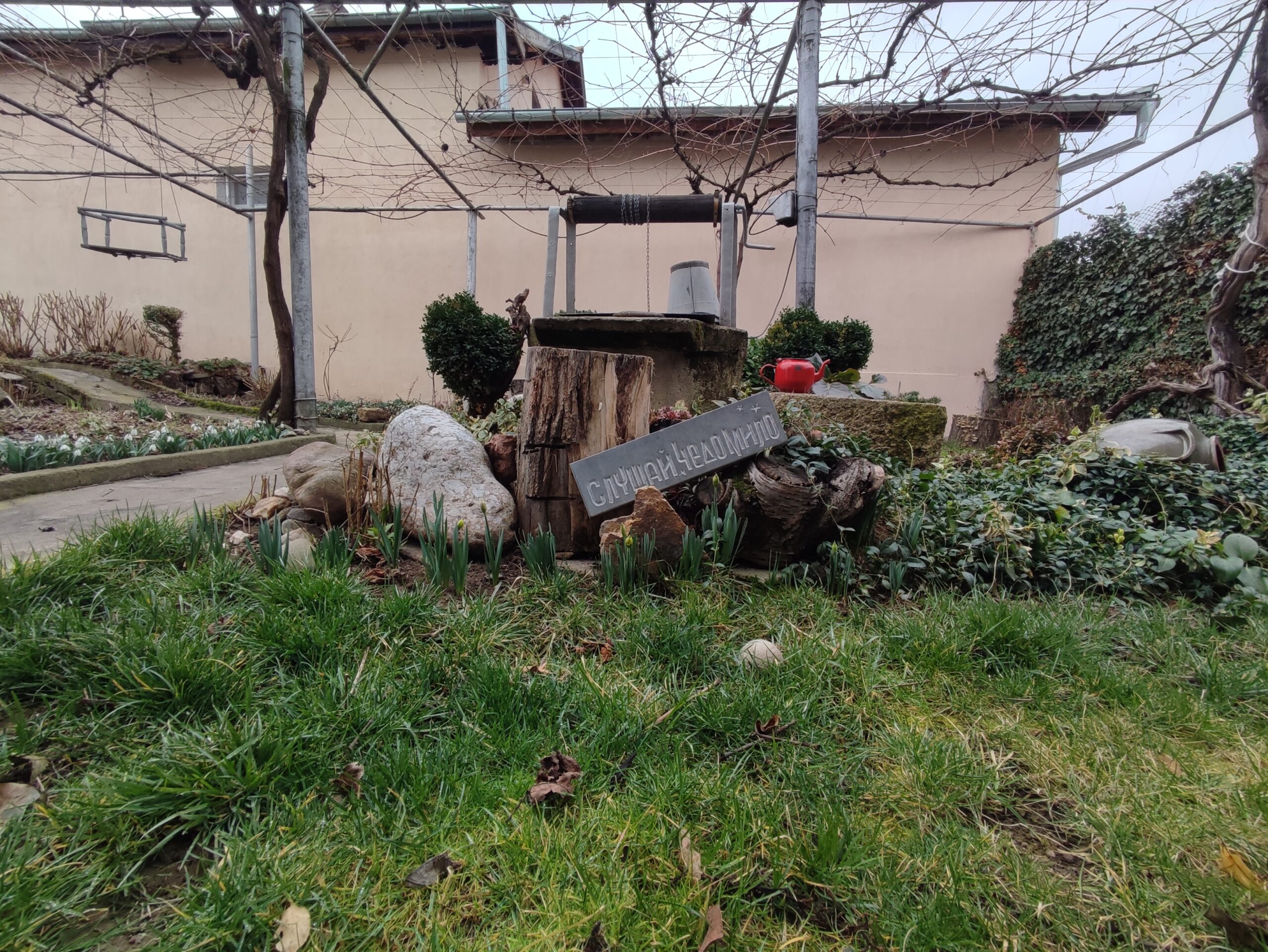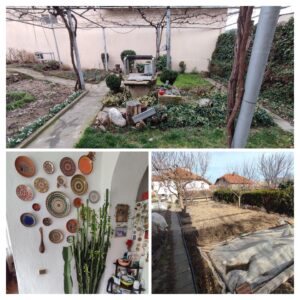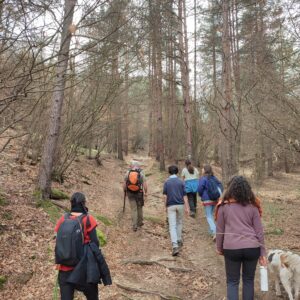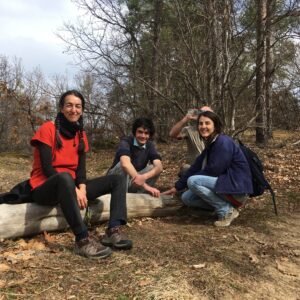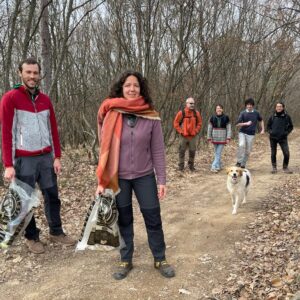Peter and Anastasja:
Dear readers,
As promised last week, in this week’s blog post, we will tell you about our wonderful weekend in Buzovgrad. Buzovgrad is a small village close to Shipka, surrounded by rose-fields and Thracian tombs. We were hosted there by our mentor Pol, who is our contact person, in case we have any emotional or psychological issues during the project, or if there is a need for a mediator. We immediately felt at home in Pol’s house. She lives with her mother Liliana and her sister Rada. They all lived in Spain for a long time, and only came back a few years ago. Therefore, we spoke a beautiful mix of Spanish, English, Italian, French, and Bulgarian during our stay. Besides this magnificent plurilingualism, all around the house you can find books, plates, fridge magnets, and other memorabilia which tell the family’s multicultural story. What made us love them even more, is the fact that they have their own garden, and make a whole lot of things themselves; not only food, but also soaps and balms (More about this, and especially Rada’s recipes at a later time).
UP: Decorative entrance garden with grape-vines. DOWN LEFT: Collection of plates from different places. DOWN RIGHT: Main vegetable garden with straw cover/mulch. (photo credit: Peter Spornberger)
Megalith
(photo credit: Peter Spornberger, Anastasja Giacomuzzi)
On Saturday Pol wanted to show us one of her favorite places in Buzovgrad, so we did a little hike to the so-called: MEGALITH (also known as the “Gateway to afterlife”). It was a very warm day and we were lucky to catch some sun too.
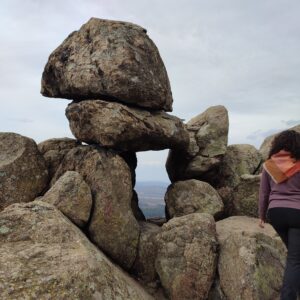
(photo credit: Peter Spornberger, Anastasja Giacomuzzi)
We arrived after an easy 1 hour walk and collecting some trash on the way. The sight of the megalith was really worth the way. What a beauty! We where very impressed and jumped imediately on it.
Ancient people used tho gather here on the evening of the summer equinox (21st of June). As the sun was setting on the horizon the last sunbeam fell through the opening of the megalith and illuminated a rock in front of it. However, no one knows how and why this structure was originaly created. Pol told us that people still gather here to witness this event and have started to create their own rituals around it.
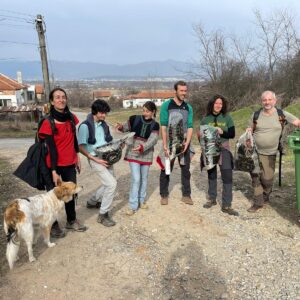
(photo credit: Mihaela Tsarchinska)
During our hike we collected some trash, even though the path was actually really clean because the local eldery club looks after it . Overall it was a very nice hike and we recommend it.
Sirni Zagovezni
Pol is not only our mentor, but she is also in charge of Buzovgrad’s chitalishte (читалище), the community center. There she organizes workshops, community events, the library, readings, art classes, wine tastings, … the list could go on and on. It is inspiring how much dedication Pol puts into the community center, to connect the villagers, keep traditions alive, and encourage the youth in trying new things. Here is a link to the Buzovgrad Chitalishte Facebook page (НЧ “Любен Каравелов-1921” Бузовград | Kazanluk | Facebook), in case you are curious. Maybe you can find us on some of the pictures 😉 .
On Sunday, Pol invited us to help her with the Sirni Zagovezni celebration in the community center. Sirni Zagovezni is celebrated in Bulgaria the day before the 40-day fasting period leading up to Easter. During this fast, Bulgarians refrain from eating eggs and dairy products. Therefore, Sirni Zagovezni is the day to fill your belly with cheese and eggs!
We helped Pol with preparing the community center for the festivity, and as the locals arrived they brought homemade Banitsa, Halva, eggs, and other snacks with them. It was delicious and our bellies were definitely full. Despite this, we were able to join in some traditional dances, and had a lot of fun stumbling over our own feet.
Us dancing with the locals in the community center (photo credit: Mihaela Tsarchinska)
There are a few other traditions on this day: until the evening, it is customary to visit older people and ask for forgiveness. Like this, one is called to think of intentional and unintentional hurt they may have caused, and on the other hand, to learn to forgive such hurtful actions.
Later, the ritual of hamkane is performed. An egg or a piece of very hard white halva is tied to a thread. Then the thread is swung around and the children try to catch the prize with their mouths, without using their hands.
As a last ritual, usually big bonfires are made, and people jump over them to cleanse themselves from evil spirits. We were unlucky because it was very windy in the afternoon, and we decided that it would be safer to not make a fire. However, as the night fell, the wind also diminished. A few of the local youth decided to take matters in their own hands, and made a small fire in the yard next to the community center. At last, we jumped over the fire as well!
Sirni Zagovezni bonfire in Buzovgrad (photo credit: Peter Spornberger)
Overall, all these rituals are supposed to help us make peace with the past, cleanse, and prepare ourselves for the rebirth which comes in spring.
Martenitsa workshop
On Monday we were again in the community center for a Martenitsa workshop. Making Martenitsi is a tradition which goes back to Thracian times, or maybe even before. Bulgarians make Martenitsi for the first of March, the day of Baba Marta (grandma Marta). Baba Marta symbolizes the month of March; she is grumpy and moody, just like the weather in March in Bulgaria. Therefore, on the first of March Martenitsi are exchanged with family and friends, in an effort to make Baba Marta happy and merciful.
Martenitsi are usually red and white to symbolize health/vitality, and purity respectively. Other colors like green for nature can be added as well. Moreover, the figures of the Pizho and Penda (Пижо и Пенда), a male (white) and female (red) doll, can be seen everywhere. Martenitsi can be bracelets, as well as figures that are pinned to the chest, and pompons which are hung up in the house.
UP: Anastasja tying a martenitsa for Peter (photo credit: Mihaela Tsarchinska). DOWN LEFT: The martenitsi we made during the workshop (photo credit: Peter Spornberger). DOWN RIGHT: The martenitsi on our wrists (photo credit: Mihaela Tsarchinska).
When you tie a martenitsa around someone else’s wrist, the recipient expresses a wish as the knot is tied. The bracelet then collects energy as you wear it, and releases the wish once the bracelet is taken off. The martenitsi should be worn until the first storks appear and the trees start blossoming, bringing spring with them. Then, you should leave the martenitsa on a blossoming tree. We made our martenitsi out of organic wool, so the trees won’t mind our little gift.
More stories coming soon!
Peter and Anastasja

